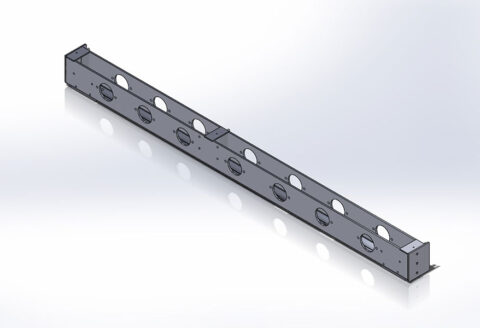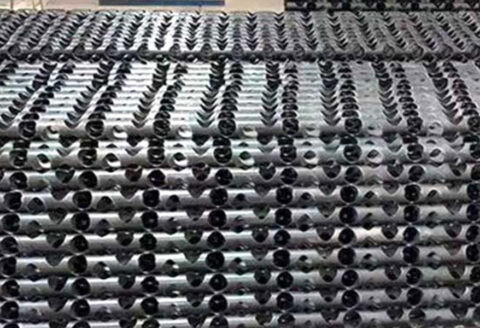The reasonable selection of welding methods and processes in the manufacturing process of power batteries will directly affect the cost, quality, safety and consistency of the batteries. Next, the laser cutting manufacturer will co-create the laser to sort out the welding content of the power cell.
1 Principle of laser welding
Laser welding uses the excellent directivity and high power density of the laser beam to work. The laser beam is focused in a small area through the optical system, and a high-energy concentrated heat source area is formed at the welding place in a short time, so that the object to be welded is melted, and a firm welding spot and weld seam are formed.
2Laser welding type
Heat conduction welding and deep penetration welding
The laser power density is 105-106w/cm2 to form laser heat conduction welding, and the laser power density is 105-106w/cm2 to form laser deep penetration welding.
Welding and seam welding
Through welding, the connecting piece does not need to be punched, and the processing is relatively simple. Through welding requires a high-power laser welder. The penetration depth of copper machining is lower than that of seam welding, and the reliability is relatively close.
Compared with penetration welding, seam welding only needs a low-power laser welder. The penetration of weld seam welding is higher than penetration welding, and the reliability is relatively better. However, the connecting piece needs to be punched, which is difficult to process.
Pulse welding and continuous welding
1) Pulse welding
The appropriate welding waveform should be selected when laser welding. Common pulse waves include square wave, peak wave, double peak wave, etc. The reflectivity of the aluminum alloy surface to light is too high. When a high-intensity laser beam is emitted to the surface of the material, the reflection on the surface of the material will lose 60% ~ 98% of the laser energy, and the reflectivity will change with the change of the surface temperature. In general, sharp waves and bimodal waves are the choices for welding aluminum alloys. The slow part of the welding waveform has a longer pulse width, which can effectively reduce the generation of pores and cracks.
Pulse laser welding samples
Due to the high reflectivity of the aluminum alloy to the laser, in order to prevent the vertical reflection of the laser beam from the vertical incidence, the laser focusing mirror is damaged. During the welding process, the welding head usually deflects at a certain angle. With the increase of the laser inclination angle, the diameter of the solder joint and the effective joint surface diameter increase. When the laser inclination angle is 40°, the titanium machining point and the effective bonding surface are obtained. The weld depth and effective penetration decrease with the increase of the laser inclination angle. When the weld depth is greater than 60°, the effective weld depth drops to zero. Therefore, when the inclined welding head is at a certain angle, the depth and width of the weld can be appropriately increased.
In addition, the welding seam is the boundary during welding, and 65% of the laser points are offset from the cover plate and 35% of the shell for welding, which can effectively reduce the explosion caused by the closure problem.
2) Continuous mode welding
Continuous laser welding is not suddenly cold or hot like a pulse machine, and the tendency of cracks in the welding process is not obvious. In order to improve the quality of the weld, continuous laser welding is used. The surface of the weld is smooth, free of splashes and defects. No cracks were found in the weld. In aluminum alloy welding, the advantages of continuous laser are obvious. Compared with the traditional welding method, the production efficiency is high and no wire is needed; compared with the pulse laser welding, it can solve the defects such as cracks, pores, and spatter after welding, and ensure that the aluminum alloy has good mechanical properties after welding; There is no concave surface, the amount of polishing and grinding after welding is reduced, and the production cost is saved. However, because the spot of the continuous laser is relatively small, the assembly accuracy of the workpiece is high.
Continuous laser welding sample
In the welding of power batteries, the welding process technicians will select the appropriate laser and delrin machining parameters according to the customer’s battery material, shape, thickness, strength requirements, including welding speed, waveform, peak value, welding head inclination, etc. to set reasonable welding parameters, To ensure that the welding effect meets the needs of power battery manufacturers.
Advantages of laser welding
Concentrated energy, high welding efficiency, high processing accuracy, and large weld depth-to-width ratio. The laser beam is easy to focus, align and be guided by optical instruments, can be placed at a proper distance from the workpiece, and can be guided between clamps or obstacles around the workpiece. Due to the above space constraints, other welding rules cannot be used.
The welding energy is controlled accurately, the welding effect is stable, and the welding appearance is good;
Non-contact welding, optical fiber transmission, good accessibility and high degree of automation. When welding thin wires or thin wires, there is no remelting problem as easily as arc welding. The core of the power battery, due to the principle of “light weight”, usually uses lighter aluminum material and needs to be made thinner. Generally, the shell, cover, and bottom plate are required to be less than 1.0mm. The basic material thickness of mainstream manufacturers is about 0.8mm.
It can provide high-strength welding for various material combinations, especially the welding between copper and aluminum. This is also a technique that can weld nickel plating and copper together.
4. Difficulties of laser cutting process
At present, aluminum alloy battery shells account for more than 90% of the entire power battery. The difficulty of welding is that aluminum alloy has high reflectivity and high pore sensitivity during welding. There will inevitably be some problems and defects in the welding process, among which the main ones are pores, thermal cracks and explosions.
There are two main types of pores in laser welding of aluminum alloys: hydrogen pores and bubble bursts. Because the laser welding cooling rate is too fast, the hydrogen hole problem is more serious, and in :cnc milling china, more holes are generated due to the collapse of the small holes.
Hot cracking problem. Aluminum alloy is a typical eutectic alloy, and it is prone to hot cracks during welding, including weld crystallization cracks and HAZ liquefaction cracks. Eutectic segregation will occur in the weld zone, leading to melting of the grain boundaries, and liquefaction cracks will form at the grain boundaries under stress, which will reduce the performance of the welded joint.
Explosion (also known as splash) problem. There are many factors that cause explosions, such as the cleanliness of the material, the purity of the material itself, the characteristics of the material itself, and the stability of the laser play a decisive role. The surface of the shell is convex, and there are pores and bubbles inside. The main reason is that the fiber core diameter is too small or the laser energy is set too high. It is not that some laser equipment suppliers advocate “the better the beam quality, the better the welding effect”. The electron beam has good quality and is suitable for superposition welding with large penetration depth. Finding the right process parameters is the key to solving this problem.
Other difficulties
For the welding of soft-covered lugs,cnc turning china is required, and the welding rod lugs must be pressed tightly to ensure the welding gap. It can realize high-speed welding of complex trajectories such as s-shaped and spiral, increase the joint area of the weld, and enhance the welding strength.
The welding of the cylindrical iron core is mainly used for the welding of the positive electrode. Because the negative electrode shell is thin, it is easy to weld through. For example, some manufacturers use the negative electrode welding process, and the positive electrode uses laser welding.
When the square battery pack is welded, the pole pieces or connectors are seriously polluted. When welding connectors, pollutants are decomposed, and welding explosion points and holes are easily formed; the battery is extremely thin, with a plastic or ceramic structure underneath, which is easy to weld through. When the electric pole is small, it is easy to weld the plastic to burn, forming an explosion point. Do not use multi-layer joints. There are pores between layers, which makes it difficult to weld firmly.
The important process in the welding process of the square battery is the packaging of the outer cover, which can be divided into upper cover welding and lower cover welding according to different positions. Due to the small size of the batteries produced by some battery manufacturers, the battery shell is manufactured by a “deep drawing” process, and only the upper cover needs to be welded.
Square power battery side welding sample
The welding methods of prismatic batteries are mainly divided into two types: side welding and top brass machining. The main advantage of side welding is that it has less impact on the inside of the battery, and splashes will not easily enter the inside of the casing cover. Because bumps may be generated after welding, which will slightly affect the assembly of the subsequent process, the side welding process has high requirements on the stability of the laser and the cleanliness of the material. However, because the top welding process is welded on one surface, the requirement for the integration of welding equipment is low, which is convenient for mass production. However, there are two shortcomings: one is that a small amount of splash may enter the battery during the welding process; the other is that the front part of the shell has high processing requirements, which will cause cost problems.
5 Influencing factors of welding quality
Laser welding is the main method of battery welding. Laser welding is a process in which high-energy beam laser irradiates the workpiece, which causes the working temperature to rise sharply, and the workpiece is melted and reconnected to form a connection. The shear strength and tear strength of laser welding are better. The quality of battery welding, its conductivity, strength, air tightness, metal fatigue and corrosion resistance are all typical welding quality evaluation standards.


